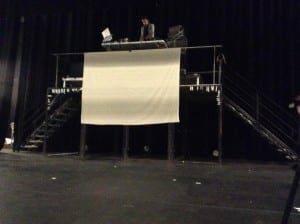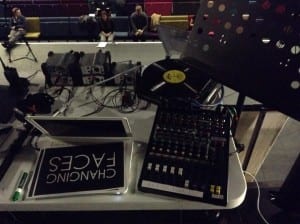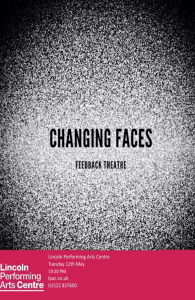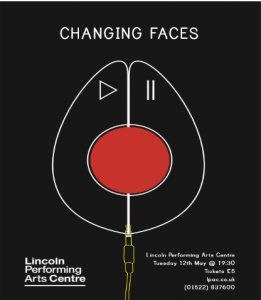1. The process
This process has been one of a rollercoaster to say the least, its been ripe with changing ideas and finalising and swapping the entire concept of the show.
2.1 roving backstage– March 10th
A couple of weeks back now we did the exercise where we recreated a film scene live on stage. Bryony’s group recreated the famous ear cutting scene from Tarantino’s Reservoir Dogs. In the re-enactment, at one point, Hal removed the camera from its fixed station and follows bryony through to the workshop, all the while the scene in front of us still carries on (see figure 1). It sounds simple but it stood out particular because it was so effective. The reason as to why this worked so well are;
1) it did something the film couldn’t, as a viewer we got to experience an extra scene. The fact we got two simultaneous views of different things, it unlocks the potential to discover more story within the same time.
2) ‘Live’ gets a whole other meaning. “Live performance emerged not as a condition of physical proximity and co presence… but as a correlate of time” (Bay-Cheng, p.86, 2010). This technique not only exemplifies this quote but it also adds to it, not only do we have a co presence to the stage, but the fact that the camera leads us to a place out of sight gives us another co presence. As we saw action transport from stage to off stage (whilst stage was still being used) it became a more inclusive experience.
3) It was tidy. One thing that bugged me about last years group performance, The Hotel was how out of place the roving camera looked amongst the very 1930-esque look and it became distracting. Potentially having the camera ready to go just off stage and follow characters to different rooms. Gives us more space and doesn’t harm the overall look of what’s on stage. This technique has so much potential to play with… Let’s not forget it.
1.2 Another show… Another idea – April 12th
We had an idea, to stage moments in history using technology all in order to show certain aspects of these moment that couldn’t be seen at the time. The lead example of this would be recreating Marylyn Monroe’s ‘Happy birthday Mr President’ performance (the moment of history) after showing a live feed of her backstage taking pills (the way in which technology could uncover things we haven’t seen before). We then went into writing/ coming up with various scenes and ideas. In the end we had a list which contained; The Zodiac killer, Jack the ripper, Richard the third, WW2, 9/11, the moon landing, the JFK assassination and many more. At first we considered staging these as separate vignettes. What we noticed was that many of these idea all contained the theme of conspiracy so this lead us to come up with the idea that this plot should be two (or more) people attempting to recreate the conspiracy’s in order to shed some new light on them. Really we wanted the show to be a discussion of conspiracy on a whole, using these examples to illustrate our points. What was a large debate that went on when moulding this idea was will we be playing fictional characters that we have made up or not. Personally I saw us playing versions of ourselves like in Gob Squad’s Revolution Now! Or even such as in Flickbook Theatre’s Three words. (2014)Therefore we can enter and tell the audience directly our ideas and thoughts/ making them aware that this is a show whilst also being able to get away with seemingly recreating what we want at our own will by stating something like; “well look at the Richard the third conspiracy…”.
On the topic of Revolution Now! By Gob squad, I see this show following a similar style by being a show that explores the theme of conspiracy rather than attempting to uncover it, in a similar way they did with the theme of revolution by placing the “unimaginable of revolution in the here and now of our commercialist world” (Tecklenburg, 2012, p.31). However one thing that I would like to avoid, something that Revolution Now! Was guilty of, was laugh off actual debates of revolution. In one part of the show a member of the group took to the streets and interviewed members of the public (in order to hear ‘what the people want’). Mostly, their participants were shy and making light of the topic matter. However one participant, a man in a black cab, started speaking about (what he believed) to be the problems with the concept of revolution. His ideas were quickly dismissed and not mentioned again. Instead the group found another quite shy participant and told how to act how he was told in order to fit into the ending they wanted, therefore completely undermining the basic idea of revolution all together. I want our show to be an exploration and investigation of the subject matter rather than an outright mission to make fun of the concept.
1.3 Trails and techniques – April 27th
In the past week or so, we have to of hit our stride with (again) another new idea. This time we have scenes and firmer grip on things. With new ideas comes new scenes and with new scenes comes different ideas for techniques. Specifically what is intrusting is how we interacted with our many different mediatized elements of the piece.
the columbine scene is the scene that exemplifies this the best. One aspect of this scene will involve fixing a GoPro to the barrel of a gun. Whilst Brad and I are onstage we are going to point it at the audience, showing their reaction on a screen behind us. The technical thinking behind this is to;
1) show a different angle we all come to expect of this type. Making it feel personal for the audience. 2) Represent the real life boy’s obsession of self image.
3) Represent the behind the scenes of history theme were using.
4) Recreate the ‘Doom’-esque shot that, as a result of this was banned from videogames.
Then, with the ‘gun cam’ we are going to run off stage and into the library where we will perform a staged shooting. What the audience will see is a traveling video taking us off stage to another place. We are using the technology to experiment with what space can be implemented live, on stage. We will also draw attention to the video by having it play unaccompanied onstage as this happens.
2. The writing
2.1 early on/ what hasn’t been used – Wednesday 13th May.
Before we had a solid idea for the show my job as a writer consisted of responding to different briefs given to me by the directors. The briefs the writers were given were quite open ended, so it gave us a large creative field to work in. one thing I tried to keep in mind when writing these various scripts was “synthesizing the distinct languages of media and theatre in order to reflect onstage the multi-faced content of contemporary culture” (Wehle, 2002, p.139). I found this quote particularly important as it exemplified what I wanted to do within these scenes, not only did I want to write scenes that would be interesting to stage with multimedia. But I also wanted to write scene which included multimedia in the themes of its story.
One particular piece that I would like to mention was a scene I wrote in which I had to write a scene that responded to dark thoughts’. Earlier in the process we had looked at monologues we found online that dealt with the topics of dark thoughts. This, along with my own personal experience of depression inspired me to write a scene.
The scene was meant to be set with minimal light and to revolve around a man onstage about to jump of a building and a voice of stage trying to talk him down. The scene uses static interference as a general metaphor for depression this is so I fulfil the criteria that Jon Ginman lays out as ,trying to inspire “spectators to feel they want to, maybe need to, attend the performance in person” (2013, p.132).
“Voice. Concentrate on the interference. Listen to it. Is it still there?
Man. Yes.
Voice. Make it louder. Make it so loud you can’t bear it.
We hear the sound of interference get louder and louder until it becomes unbearable.
Voice. Now listen to the wind. Listen to the city. Hear the footsteps and hear the traffic. Let it break through the interference.
We hear the interference slowly fade out as the city noise come into the foreground at a reasonable volume.”
For this scene I looked at some excerpts from Richard foreman’s notebooks to help me with this quick dialogue. As In terms of its style the dialogue was intended to be quite short and snappy, this is so pace can be played around with a lot. This is due to this scene relying heavily on it use of sound and its rapid or gradual build.
it didn’t get used simply because the idea of our piece changed. Yet I thought this would have been an interesting scene to have seen staged and I believed it met much of the criteria we were hoping to achieve with this module.
2.2 Finding Hitler’s voice – Wednesday May 13th
In terms of writing, the Hitler scene was the toughest to crack. Eventually what I was working on didn’t get used and the idea was changed completely. The Hitler scene originally involved performing a lip dub of some of his home videos that can be found online. I find this particularly Interesting because the usual image of Hitler is one of a mad dictator screaming at a podium. What we want to do is show a different mediatized form of Hitler, moving past the propaganda and into his private world. (see figure 2) What is especially different from the archived footage to the home movies is the way he interacts with people. This, along with the realistic and casual speech of what we are trying to achieve brings Hitler into the age where self captured videos are ubiquitous through the websites like YouTube.
This was also the reason it was so hard to script. The realistic and natural tone of the piece I wanted to create had to be broken sometimes by a hard reminder of the horrors that Hitler achieved during the war. Not only at times did it end up being too sinister and at others too light hearted but the feeling of spontaneity of the speech that had to go hand in hand with the tone was hard to get right. This had to be believable dialogue and ultimately it was just too hard to believe.
3. The performing.
Throughout this process I’ve always known that I would end up performing, but it was quite late into the rehearsals where I realised it’s I would be primarily marked on.
3.1 Churchill – Saturday 9th May

As per the director’s instructions and my own knowledge of the type of theatre we were trying to create. I was asked not to perform it as if I were playing Churchill himself, yet I simply played it as a man in control. This was the aspect we aimed to show. To do this I took an approach similar to one I adopted in Advanced Acting Technique. This was something I couldn’t really do in other scenes as this had a different discipline to the others. What this entailed was reading through the speech and using actions and tasks. This helped me to focus on the moments in which needed clear and concise meaning behind them, so I can covey the moments of control successfully. To do this as in much detail as I could I researched the when and why the speech was delivered. (see figure 3) Although I was not actually playing the man himself, I wanted to get as much context as I could so I could get across the correct meaning and find the places in where the control was most prominent in the speech.
3.3 The onstage demur. -Wednesday May 13th
During the change over of each scene and in some scenes we were required to act and Walk in a certain way. This was described by the directors to be, “poised” and “with purpose”. We were asked to do this as we wanted to draw attention to the media in certain parts of the play. This is something that I found quite similar to an approach that the builders association used in their performance of Jet Lag (1998). They, like us, played around with the concept of drawing attention to both the actors and the mediatized at different times. Although they achieved this in a different ways we still had a similar goal of making it so, “the live performer is no longer the centre of attention, the media is the real protagonist” (Wehle, 2002, p.138). In our play we wanted to create a stage picture that looked quite busy but also controlled, the way in which you would imagine crew members of a TV or film studio to behave. This was crucial in the scene in which the queen (Cherry) is seen ‘behind the scenes’ at her coronation, here I played the cameraman capturing the unseen emotions we hypnotized that the queen would be feeling at that time. The importance to remain poised and purpose was essential here as I didn’t want to take attention away from Cherry but yet my presence alone helped highlight the mediatized element within the scene and my purposed attitude helped atone to the importance of the camera.
I think me and the class achieved this generally in the show, but as this was kind of a last minute, slap-dash addition to the piece with more rehearsal and maybe if it were directed with a more choreographed approach it could have looked more polished.
Bey Cheng, S. (2010) Temporality. In: Sarah Bay-Cheng, Chiel Kattenbelt, Andy Lavender, and Robin Nelson (eds.) Mapping intermediailty in performance. Amsterdam: Amsterdam University Press
Tecklenburg, N. (2012) ‘Reality Enchanted, Contact Mediated: A Story of Gob Squad’, TDR: The Drama Review, 56 (2) 8-33.
Whele, P. (2002) Live performance and technology The Example of Jet Lag. PAJ: a Journal of Performance and Art. 24 (1) 133-139
Ginnman, J (2013) The Vital importance of being present: Writer development for Theatre in a Mediatised Age. Contemporary Theatre Review. 23 (2) 128-136.
















